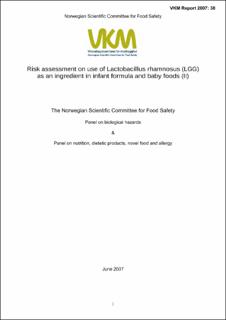| dc.contributor.author | Rimstad, Espen | |
| dc.contributor.author | Andersen, Lene Frost | |
| dc.contributor.author | Frølich, Wenche | |
| dc.contributor.author | Frøyland, Livar | |
| dc.contributor.author | Halvorsen, Ragnhild | |
| dc.contributor.author | Høiby, Ernst Arne | |
| dc.contributor.author | Kapperud, Georg | |
| dc.contributor.author | Lunestad, Bjørn Tore | |
| dc.contributor.author | Lassen, Jørgen Fredrik | |
| dc.contributor.author | Meltzer, Helle Margrete | |
| dc.contributor.author | Narvhus, Judith Ann | |
| dc.contributor.author | Nygård, Karin | |
| dc.contributor.author | Nesbakken, Truls | |
| dc.contributor.author | Olsvik, Ørjan | |
| dc.contributor.author | Paulsen, Jan Erik | |
| dc.contributor.author | Robertson, Lucy Jane | |
| dc.contributor.author | Tranulis, Michael A. | |
| dc.contributor.author | Tryland, Morten | |
| dc.contributor.author | Vainio, Kirsti | |
| dc.contributor.author | Haugen, Margaretha | |
| dc.date.accessioned | 2022-12-28T11:55:32Z | |
| dc.date.available | 2022-12-28T11:55:32Z | |
| dc.date.created | 2017-12-31T13:45:59Z | |
| dc.date.issued | 2007 | |
| dc.identifier.citation | Halvorsen, R., Narvhus, J., Eggesbø, M. Å., Olafsdottir, E. J., Andersen, L. F., Frøyland, L., ... & Løvik, M. (2005). Risk assessment on use of Lactobacillus rhamnosus (LGG) as an ingredient in infant formula and baby foods. The Norwegian Scientific Committee for Food Safety Panel on Nutrition, Dietetic products, Novel food and Allergy. VKM Report. | en_US |
| dc.identifier.uri | https://hdl.handle.net/11250/3039633 | |
| dc.description.abstract | On 10. March 2006 , The Norwegian Food Safety Authority (Mattilsynet) decided that, on the basis of VKM’s previous risk assessment (2005), Nutramigen 1 with Lactobacillus rhamnosus GG (LGG) could not be marketed in Norway as medical foods for infants (0-4 months). In addition, The Norwegian Food Safety Authority (Mattilsynet) decided (08. November 2006) to withdraw permission for marketing of Nutramigen 2 with LGG, which is a milk supplement for infants aged between 4 and 6 months, with cow’s milk and soy protein allergy. On 13. December 2006, Mead Johnson Nutritionals appealed against this decision from The Norwegian Food Safety Authority (Mattilsynet). The Norwegian Food Safety Authority forwarded the appeal from the companies, asked the VKM Panel on biological hazards and the VKM Panel on nutrition, dietetic products, novel food and allergy, for a new risk assessment including the new data provided in the appeal. LGG is one of the most studied probiotic strains. Lactic acid produced by LGG in the human gut results in a decrease in faecal pH, which in turn inhibits colonisation by potentially pathogenic bacteria. Short-term beneficial effects from administration of LGG to infants and young children with infectious diarrhoea have been reported in a number of studies, but a prophylactic effect on diarrhoea has not been documented. Furthermore, whilst some studies have reported a prophylactic, or even a curative, effect of LGG on atopic eczema in young children, more recent studies do not report such effects. Some even suggest an increased incidence of allergic sensitization in children receiving LGG supplemented formula at an early age. There are no published data that demonstrate long-term clinical benefits of infant formula supplemented with LGG for children between 4 months and 3 years, although no immediate deleterious effects of LGG have been found. Possible long-term effects of LGG on intestinal colonisation, and its effects on long-term gastrointestinal and immune functions, are not known. LGG, as an ingredient in infant formula and baby foods, is intended for daily use in the target group, and not for short-term, specific treatment. Furthermore, the targeted consumer group includes children below the age of twelve months. These two aspects demand particular consideration with regard to the unknown effects of longterm treatment with large doses of live bacteria on the ecology of the microbiota of the gastrointestinal tract and on the immune system. Neither of these systems is fully matured in infants and small children, and therefore may be particularly susceptible. Norwegian Scientific Committee for Food Safety There is no documented prophylactic effect of LGG on any disease in children. The effect of treatment with LGG-supplemented formula in small children is questionable, except for a documented short-term effect on infectious diarrhoea. Panel on Biological Hazards and Panel on nutrition, dietetic products, novel food and allergy at the Norwegian Scientific Committee for Food Safety find that the data available are not sufficient to support the suggested beneficial effects, or the safety, of LGG in infant formula and baby foods for children aged between 4 months and 3 years, when the products are intended for daily use. | en_US |
| dc.language.iso | eng | en_US |
| dc.publisher | Norwegian Scientific Committee for Food Safety (VKM) | en_US |
| dc.relation.ispartof | VKM Report | |
| dc.relation.ispartofseries | VKM Report; | |
| dc.relation.uri | https://vkm.no/download/18.13735ab315cffecbb51fb56/1501077416972/63bb45d3eb.pdf | |
| dc.title | Risk assessment on use of Lactobacillus rhamnosus (LGG) as an ingredient in infant formula and baby foods (II) | en_US |
| dc.type | Research report | en_US |
| dc.description.version | publishedVersion | en_US |
| dc.rights.holder | Norwegian Scientific Committee for Food Safety | en_US |
| dc.subject.nsi | VDP::Landbruks- og Fiskerifag: 900 | en_US |
| dc.source.pagenumber | 32 | en_US |
| dc.source.issue | 2007:38 | en_US |
| dc.identifier.cristin | 1533160 | |
| cristin.unitcode | 217,7,6,0 | |
| cristin.unitname | Norsk hotellhøgskole | |
| cristin.ispublished | true | |
| cristin.fulltext | original | |
